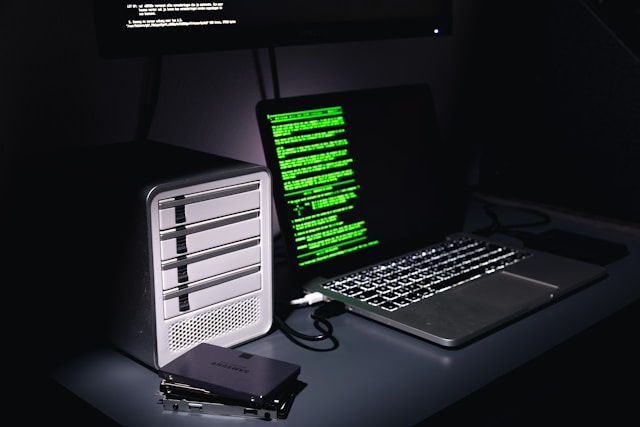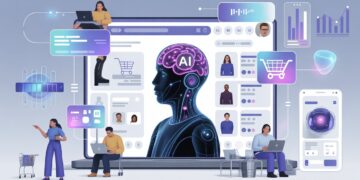Cybersecurity has become one of the most pressing challenges of the digital era. With businesses, governments, and individuals relying heavily on connected technologies, the risk of cyberattacks grows every year. Traditional security tools are no longer enough to keep pace with increasingly sophisticated threats. This is where artificial intelligence steps in.
The role of AI in cybersecurity is evolving rapidly, offering new ways to detect, prevent, and respond to cyber risks. But while AI-powered tools bring powerful advantages, they also come with challenges that require careful consideration.
How AI is Used in Cybersecurity Today
Artificial intelligence is not just a buzzword it is already integrated into many cybersecurity systems. Here’s how AI in cybersecurity is transforming defense strategies:
-
Real-time threat detection: AI algorithms can scan massive amounts of data across networks, flagging unusual behavior instantly. This helps identify breaches as they happen instead of after damage is done.
-
Automating repetitive tasks: Many cybersecurity operations involve routine checks, log analysis, and compliance reporting. AI streamlines these tasks, reducing human error and freeing analysts for more complex work.
-
Predictive analytics: AI models can analyze historical attack data to predict where future vulnerabilities may appear, giving companies time to patch weak points.
-
Fraud detection: In banking and e-commerce, AI identifies suspicious patterns in financial transactions, stopping fraud before it spreads.
These applications demonstrate how artificial intelligence cybersecurity solutions are moving from theory to practice across industries.
Benefits of AI in Cybersecurity
The benefits of AI in cybersecurity go beyond speed and automation. Businesses adopting AI-driven defense systems often experience:
-
Faster detection of cyberattacks: AI systems can recognize malware, phishing attempts, or ransomware within seconds, minimizing potential damage.
-
Scalability: Unlike manual monitoring, AI tools can handle massive volumes of network data without being overwhelmed.
-
Adaptive learning: Machine learning models grow smarter with every new threat, allowing them to adapt as hackers change tactics.
-
Reduced false alarms: By analyzing behavior more deeply than traditional signature-based systems, AI reduces the number of unnecessary alerts.
In short, AI makes cybersecurity more proactive, shifting the focus from reaction to prevention.
Challenges and Risks of AI in Cybersecurity
While the advantages are significant, the role of AI in cybersecurity is not without risks. Over-reliance on AI or poorly implemented systems can create vulnerabilities of their own.
-
False positives and biases: AI systems are only as good as their training data. Poorly trained algorithms may misclassify threats, creating unnecessary disruptions.
-
Adversarial AI: Hackers are also leveraging artificial intelligence to create more sophisticated attacks. From deepfake phishing emails to AI-driven malware, the technology can be used against defenders.
-
Automation risks: Relying entirely on AI without human oversight can be dangerous. Automated responses could accidentally block legitimate users or disrupt normal operations.
-
Ethical and privacy concerns: The use of AI in cybersecurity often involves analyzing sensitive personal data. Without proper safeguards, this raises privacy risks.
Recognizing these challenges ensures that AI is applied responsibly and effectively.
Why Human Oversight Still Matters
Even with the most advanced artificial intelligence cybersecurity solutions, humans remain critical to the process. AI can detect patterns and anomalies faster than people, but it cannot fully understand context, intent, or the broader consequences of an action.
Cybersecurity professionals bring strategic thinking, ethical judgment, and creativity that machines cannot replicate. A strong remote security operations team working alongside AI systems ensures:
-
Smarter interpretation of alerts and anomalies.
-
Faster identification of false positives.
-
Better decision-making during complex attacks.
AI doesn’t replace human expertise it enhances it.
The Future of AI in Cybersecurity
Looking ahead, the future of AI in cybersecurity points toward more sophisticated, integrated systems that combine automation with human intelligence. Key trends include:
-
AI-driven platforms: More companies will adopt end-to-end security platforms powered by AI, reducing the need for multiple disjointed tools.
-
Integration with big data: AI will increasingly use large-scale datasets to identify threats with greater accuracy.
-
Global standards and regulations: As AI becomes central to security, governments and organizations will push for regulations to govern its use and prevent misuse.
-
Defensive AI vs. offensive AI: A growing arms race will emerge, where defenders use AI to protect systems while attackers use it to find weaknesses.
Businesses that prepare for these developments now will be better positioned to stay ahead of cybercriminals in the years to come.
Conclusion
The role of AI in cybersecurity is clear: it has the power to make digital defenses smarter, faster, and more resilient. From real-time threat detection to predictive analytics, artificial intelligence is reshaping the way organizations defend themselves. Yet it is not a cure-all. Without human oversight, ethical safeguards, and strong policies, AI can create as many problems as it solves.









